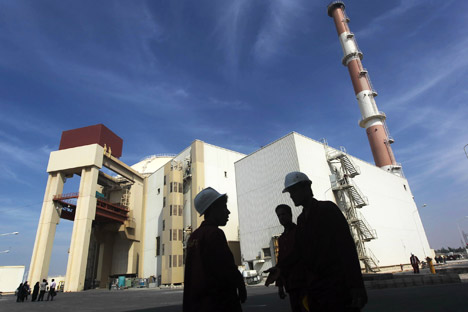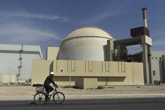Bushehr nuclear power plant handed over to Iran

The Bushehr nuclear plant began operations in 2010 when nuclear fuel was delivered into the reactor building of the under the supervision of inspectors from the IAEA. Source: Reuters
Russia handed over the first unit of the 1000-MW Bushehr Nuclear Power Plant to Iran, Alki Akbar Salahei, head of the Atomic Energy Organization of Iran said. Russian specialists will still work there over the next two years and will advise the plant staff and provide technical support.
Bushehr NPP became an active nuclear facility in August 2010. Nuclear fuel was delivered into its reactor building under the supervision of IAEA inspectors. In July 2013, the first unit of the plant reached its full capacity, but it took several months to conduct tests.
Tehran is optimistic that Russian will help it construct a second unit with the same capacity of 1000 megawatts in the near future. According to Salahei, there has been some progress in the negotiations with Moscow on this issue. “The parties, during the last meeting of the Intergovernmental Commission of Iran and Russia on Economic Issues, came to an agreement on the construction of new NPPs,” he said.
Iran plans to construct three new power units: two in the short term, and one in the distant future. The location of Bushehr allows for the construction of a total of four power units of 1,000 MW each. However, the site for these power units must first be approved by the IAEA.
Bushehr NPP is the first in the Middle East, and the most long-delayed construction project in the region. The construction of the power plant began in 1974 and the order was given to Siemens, but work stopped after Iran’s Islamic Revolution in 1979. Russia’s Atomstroyexport recommenced construction after 1998.
Related:

Moscow, Tehran to sign agreement on building new nuclear power plant
Russia expects continuity in Iran cooperation after Rouhani’s election
Iran leader asks Putin for go-ahead to build new nuclear plant
Rosatom considers the Iranian NPP to be a unique plant, since Russian equipment had to be integrated into the construction work made to German designs, and they also had to use about 12,000 tonnes of German equipment.
Experts are cautious about the prospects of Russia's participation in the construction of other power plants in Iran. On the one hand, this is profitable from the commercial point of view. If Moscow refuses the project, this tasty morsel can be taken by China, which wishes to expand its influence in Iran. However, there are risks due to the international sanctions against Tehran.
Now is not the best time for economic cooperation with Iran, because the country is in a very difficult financial situation, it is losing $40-50 billion annually as a result of sanctions, Vladimir Sazhin, senior researcher at the Institute of Oriental Studies, Russian Academy of Sciences, and expert at the Russian Council on International Affairs (RCIA), told RIA Novosti.
In addition, international banking transactions with Iran became impossible after the SWIFT banking system stopped working with Iranian banks in 2012. “Even if Iran will find the money, how will it transfer the money officially? Many countries now owe money to Iran, including India, China, but they cannot transfer this money to Iran in the usual way,” Sazhin said.
All rights reserved by Rossiyskaya Gazeta.
Subscribe
to our newsletter!
Get the week's best stories straight to your inbox